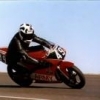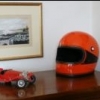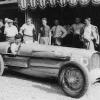
Two-stroke race cars
#1

Posted 15 August 2010 - 09:16
Did anyone have a serious 2 stroke racing car?
I seem to remember reading a SAAB 3 cylinder Formula Junior, but that its all I have heard of.
I have seen heaps of road racing sidecars with Yamaha TZ700 engines in them. But nothing on successful 2 stroke cars. And no I do not count Rotaries as 2 strokes!
Advertisement
#2

Posted 15 August 2010 - 09:34
Fiat tried an Oechselhauser type opposed piston system in 1925, but the exhaust pistons did not stand up to the hard life they had so it did not race.
The Z company of Brno, Czechoslovakia used the duplex two-stoke with a separate blower as did the Trossi Monaco.
#3

Posted 15 August 2010 - 09:39
Edited by Alexey Rogachev, 15 August 2010 - 09:39.
#4

Posted 15 August 2010 - 09:50
F. Junior and F3 in Eastern Europe in the sixties were mostly based on Wartburg 3-cylinder 2-stroke engines. For examlpe: Melkus and SEG (East Germany), Rak (Poland), many home-made cars from Czechoslovakia, Estonia 5 and Estonia 9 (USSR).
Any pics of those Alexey? Do any of them survive?
#5

Posted 15 August 2010 - 10:07
Coenraad Spencer seems to have successfully campaigned a variety of 2 stroke DKWs in races rallying and hillclimbs, whose engines allegedly only have 8 moving parts !
There was a cool looking spyder the Hartmann DKW which was raced but I know very little about.
An unknown Scottish farmer Jim Clark made his racing debut in a #4 DKW and Juan Manuel Fangio appears to have competed in one as well.
I imagine our experts from behind the former Iron Curtain can tell us about the 2 stoke success of the Wartburg and Trabandts in eastern Europe whose engines were almost certainly used in a number specials including this #102 Wartburg Eigenbau seen in the hands of Frank Menzel.
Edited by arttidesco, 15 August 2010 - 10:08.
#6

Posted 15 August 2010 - 10:09
#7

Posted 15 August 2010 - 10:17
For most of my Motorcycle racing life I raced 2 strokes.
Did anyone have a serious 2 stroke racing car?
I seem to remember reading a SAAB 3 cylinder Formula Junior, but that its all I have heard of.
I have seen heaps of road racing sidecars with Yamaha TZ700 engines in them. But nothing on successful 2 stroke cars. And no I do not count Rotaries as 2 strokes!
There was a swedish formula 2 effort in 1981:
http://forums.autosp...a...st&p=793552
#8

Posted 15 August 2010 - 10:18
#9

Posted 15 August 2010 - 10:55
The late, great, Peter Arundell won the John Davy Trophy at the Boxing Day Brands Hatch meeting in an Elva-D.K.W. in 1959
Edited by Bloggsworth, 15 August 2010 - 11:00.
#10

Posted 15 August 2010 - 11:29
The late, great, Peter Arundell won the John Davy Trophy at the Boxing Day Brands Hatch meeting in an Elva-D.K.W. in 1959
But within months most of the Elva owners had realised the A-Type BMC was better suited to purpose - and everyone else was finding the 105E Anglia unit better still.
OTTOMH, only Gerhard Mitter's DKW-powered Juniors remained competitive
#11

Posted 15 August 2010 - 11:40
[/quote]
It looks just a little out classed!
#12

Posted 15 August 2010 - 11:50
#13

Posted 15 August 2010 - 12:05
Ron Marchant's Lotus 23, details here, was powered by 6 Ariel Arrow 250 twins attached to a common shaft? Synchronisation was a problem! The Rotorvic engine is now in the Donnington Collection.
Edited by Bloggsworth, 15 August 2010 - 12:06.
#14

Posted 15 August 2010 - 12:10
#15

Posted 15 August 2010 - 12:57
]#102 Wartburg Eigenbau[/url] seen in the hands of Frank Menzel.
It looks just a little out classed!
Well that's historic racing for you
#16

Posted 15 August 2010 - 13:03
In late 1939, Earl Howe announced that he was going to fit a blown two-stroke engine in his ERA. It was supposed to make its debut at the cancelled Zurich meeting in October, having been written up in both Autocar in August and Motor Sport in September, but I've never seen anything else about it (apart from an Italian newspaper report based on the Autocar article). Does anyone know if it ever got anywhere near a track - or even if the engine ever met the chassis?
Couldn't find anything on the net about the 2 stroke ERA, but here is an interesting snipet on a planned 2 stroke inverted Mercury Marine V12 planned by Briggs Cunningham ... that never materialised
#17

Posted 15 August 2010 - 13:24
There were some successes. Jim Hall won the Sebring FJ race in March in an Elva-DKW. Steve Wendt won the FJ race at the Road America June Sprints in an Elva-DKW. A 100 mile USAC professional FJ race at Road America July 20, 1960, was won by Curt Gonstead in an MBM-DKW. I imagine that there were others. Alan Connell also had a DKW in his Cooper T-52.
Jeff Miller has won six SCCA class championships over the years with a two stroke Kohler engine in various Lola chassis.
Tom
#18

Posted 15 August 2010 - 13:37
Paul M
#19

Posted 15 August 2010 - 14:00
Advertisement
#20

Posted 15 August 2010 - 16:30
The current formula calls for a 500cc engine, but basic car is similar.
#21

Posted 15 August 2010 - 16:31
#22

Posted 15 August 2010 - 17:24
Six x cylinder 16 pistons.
Make that 12 pistons, and I'd agree with you. This engine has long interested me, but I've only read about it, never seen a drawing. As I understand it, there were six paired cylinders, with a single casting that incorporated all twelve heads, and an ingenious intake one side, exhaust the other crossflow arrangement. Can anyone point us in the direction of some better info?
#23

Posted 15 August 2010 - 17:45
Here are some photos of the Wartburg-powered cars from Eastern Europe:Any pics of those Alexey? Do any of them survive?
Melkus 61 (Leningrad, 1961, CAMK International Trophy) :

Rak 61 (Leningrad, 1961, CAMK International Trophy) :

Melkus 62 (Leningrad, 1962, CAMK International Trophy) :

Rak 62 (Leningrad, 1962, CAMK International Trophy) :

Estonia 5 (Tallinn, 1962, USSR Championship, round 1) :

Melkus 63 (no. 22), Estonia 9 (66), Melkus 64 (63, 7) (Kaunas, 1966, USSR Championship, round 2) :

Melkus 64 (no. 63), Estonia 9 (66), (Budapest, 1966, the Cup of Peace and Friendship, round 1) :

MGK (Minsk, 1970, the Cup of Peace and Friendship, round 2) :

#24

Posted 15 August 2010 - 18:52
#25

Posted 15 August 2010 - 19:15
I think I read somewhere that under racing conditions the middle cylinder of the 3-cylinder DKW engine tended to overheat, which was one reason they were unpopular for FJ.
Edited by D-Type, 15 August 2010 - 19:16.
#26

Posted 15 August 2010 - 19:27
I recall D Sports Racers with two-strokes were not uncommon in SCCA racing in the late 1960s-early 70s. They made an awful racket but killed the mosquitoes.
One of the more popular 2-strokes in DSR was the Suzuki GT750 "Water Buffalo" usually modified by Ocelot Engineering. Variations of the Rotax 494 and other snowmobile engines have also been used in DSR and the (SCCA) F500 class. Some Outboard Marine engines were used at times in the Modified/SR class, like McCulloch and Mercury.
A few years back (2005 maybe), someone found a loophole in the SCCA FC ruleset, and brought some sort of 2-cycle MC engined car to the Runoffs. It seems that any sub 1100 motor was allowed, as an artifact of the old Formula C rules. The rest of the field protested under the "strained and tortured interpretation" rule, the car excluded from running, and the Formula Car Specification rules rewritten to eliminate the loopholes.
#27

Posted 15 August 2010 - 19:32
#28

Posted 15 August 2010 - 20:00
#29

Posted 15 August 2010 - 21:33
#30

Posted 15 August 2010 - 21:55
Mac's-It Special, as I recall. A two cyl two stroke at each corner. As you no doubt surmise, it didn't work.There also was this bizarre 4-engines, 4-wheel drive Can-Am car ( late 60's - early 70's ? ) equipped with one two-stroke engine ( snowmobile origin ? ) attached to each of the 4 corners with an automatic transmission ? I've seen photos and read about it somewhere and I can't think where else than on TNF it could have been.....
Tom
#31

Posted 15 August 2010 - 22:01
I can vaguely remember someone running a 2 stroke of some sort in a F libre car in the 80s.
There is some very quick ones in hillclimbers at National level.
#32

Posted 16 August 2010 - 00:16
Mac's-It Special, as I recall. A two cyl two stroke at each corner. As you no doubt surmise, it didn't work.
Tom
Thank you, Tom, that's the one
For those interested if you scroll down about half way down the page linked below from the CAN-AM thread of the French AUTODIVA forum there is a post about this car . It was powered by four 800cc 2-stroke Rotax twins, and only appeared once for practice of the 1970 Laguna Seca race, driven by Hiroshi Fushida . Hopelessly slow, didn't qualify and wasn't seen anymore after .
http://www.autodiva....p...7&start=240
Edited by philippe7, 16 August 2010 - 01:55.
#33

Posted 16 August 2010 - 01:00
Roger Lund
#34

Posted 16 August 2010 - 08:03
That's the device normally known as a duplex two-stroke and was seen in cars from the Trojan utility to the Trossi Monaco and Z racers.Make that 12 pistons, and I'd agree with you. This engine has long interested me, but I've only read about it, never seen a drawing. As I understand it, there were six paired cylinders, with a single casting that incorporated all twelve heads, and an ingenious intake one side, exhaust the other crossflow arrangement. Can anyone point us in the direction of some better info?
I don't!always remember the Guidobaldi supercharged 8 cylinder 2 stroke radial-engined F1 car from 1951/52.
Was it a duplex too or a uniflow like the two-stroke diesels found in some Foden lorries?
#35

Posted 16 August 2010 - 09:11
I don't!
Was it a duplex too or a uniflow like the two-stroke diesels found in some Foden lorries?
Allan, as a non-engineer I can tell you nothing more. It has been discussed previously on various threads, with a debate about radial engines and even nos of cylinders.
I attach a phot from a magazine cover. I have the rest in the files here, and some photogrpahs of it rebuilt by the Mougins museum staff some time ago, along with the 10 cylinder engine.

Roger Lund
#36

Posted 16 August 2010 - 09:20
#37

Posted 16 August 2010 - 09:26
Just that photo tells me it's a uniflow as there is only one row of cylinders and each has a pushrod operated valve (or valves) which will be the exhaust.
The inlet arrangements don't look too clever. Wonder if it produced as much power as a blown four-stroke of the same displacement.
#38

Posted 16 August 2010 - 09:40
Rob, I suspect you may be thinking about the British Lion. This was designed by David Cox, who had worked at Brabham (on the fan car) and was based at the time in Sidmouth, Devon. The car was to be powered by an Allison gas turbine engine and had 12 wheels. Each wheel was driven (and braked) by a hydrostatic hub motor. It featured active micro-processor controlled suspension using interlinked springs, and what amounted to a joystick for driver control. The article appeared in Autosport on 3-Jan-1980, written by our own Doug Nye.Doesn't anyone here remember that Autosport article about some ridiculous 2-stroke F1 idea that I mentioned earlier? If it helps to jog anyone's memory, I think it had quite a lot of wheels, maybe eight of them, and all of them driven as far as I can remember. Yes that's what I said, an 8-wheeled F1 car, but I did say that the whole thing was ridiculous, I was surprised at the time that Autosport, which was a fairly serious magazine about motor racing in those days, wasted at least two pages on the story.
#39

Posted 16 August 2010 - 10:00
The weirdest postwar F1 of all?
Anyway, from that thread, here are DCN's comments on the British Lion:
The Lion story as published in 'Autosport' - I don't know about any other places, except maybe 'Auto Sport' Japan - was by yr fthful srvnt. I cannot recall the name of the designer, but he was ex-BAC/Tornado project, the man who'd talked Gordon Murray into trying surface cooling on the original Brabham BT46 (?) etc etc. His multi-wheeled, multi-drive, turbine-engined Lion scheme was in fact acceptable under the regulations as they then stood, and it certainly promised to be lightning fast in a straight line because its front-wheel sized tyres all round would have presented minimal frontal area. The disturbing fact was that during our interview the designer's wife kept sticking her head around the door, and carolling softly "He's a winner, you know. He's always been a winner....".
Well he lost that one.
Advertisement
#40

Posted 16 August 2010 - 10:15
Of course 12 - 16 were the Auto Unions I guessMake that 12 pistons, and I'd agree with you. This engine has long interested me, but I've only read about it, never seen a drawing. As I understand it, there were six paired cylinders, with a single casting that incorporated all twelve heads, and an ingenious intake one side, exhaust the other crossflow arrangement. Can anyone point us in the direction of some better info?
Here is a small drawing of the Zoller engine in the Austrian Allgemeine Auto Zetung
#41

Posted 16 August 2010 - 10:25
Rob, I suspect you may be thinking about the British Lion. This was designed by David Cox, who had worked at Brabham (on the fan car) and was based at the time in Sidmouth, Devon. The car was to be powered by an Allison gas turbine engine and had 12 wheels. Each wheel was driven (and braked) by a hydrostatic hub motor. It featured active micro-processor controlled suspension using interlinked springs, and what amounted to a joystick for driver control. The article appeared in Autosport on 3-Jan-1980, written by our own Doug Nye.
Thanks Tim. Well, apart from getting the number of wheels and the drive system slightly wrong, thanks for confirming that I was absolutely spot-on with everything else, especially about the bloke being a bit of a nutter. I was surprised at the time that anyone took it seriously enough for it to appear in what was in those days a well respected publication though, hardly Doug's fault, but how on earth did it ever get past the Editor?
#42

Posted 17 August 2010 - 01:46
#43

Posted 17 August 2010 - 21:11

#44

Posted 17 August 2010 - 21:29
#45

Posted 18 August 2010 - 13:35
The tuner or his son?
According to racingsportscars the #80 a Ginetta G6 driven by Wolf - Dieter Mantzel and Peter Ruby the owner Q 53rd (11:37.600) abd DNF.
Can anyone confirm if the car in Tweddells pic is either a G4 or G6 ?
Edited by arttidesco, 18 August 2010 - 13:37.
#46

Posted 18 August 2010 - 16:26
#47

Posted 18 August 2010 - 17:49
The son, then
Confirmed as the son by the Ginetta book. It was a G6, of which 3 were made to take the DKW motor.
Roger Lund
#48

Posted 18 August 2010 - 18:11
#49

Posted 18 August 2010 - 19:06
The tuner or his son?
See my post 27. Strangely the picture does not show the very high windscreen which the car was supposed to run to meet the regulations. It was officially a G6, but then the G4 1500 was called a G5, and that never caught on either.
#50

Posted 20 April 2011 - 02:46
Speedway in Oz ofcourse has had had a majority of 2 strokes in Formula 500 cars for a long time. Before the two strokes came in the gun engine was 500 Jawa solo bike engines.
Lee,
Back in 1963 Nev Waters raced a TQ speedcar at the Windsor RSL Speedway which was powered by a two-stroke Johnson outboard engine.

























